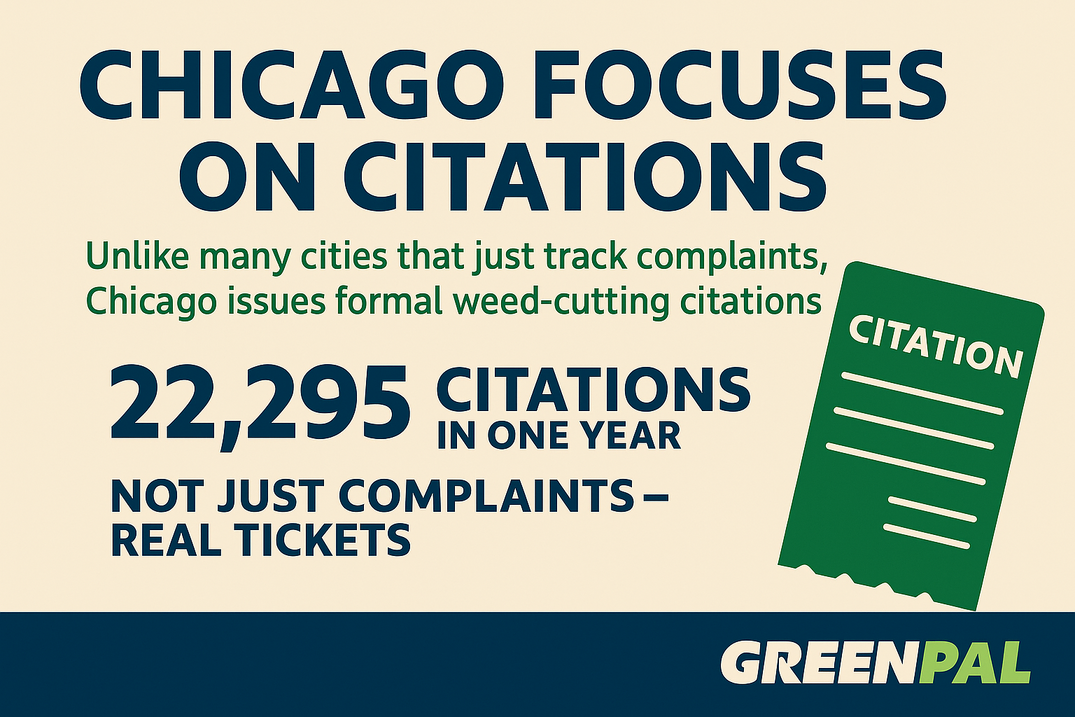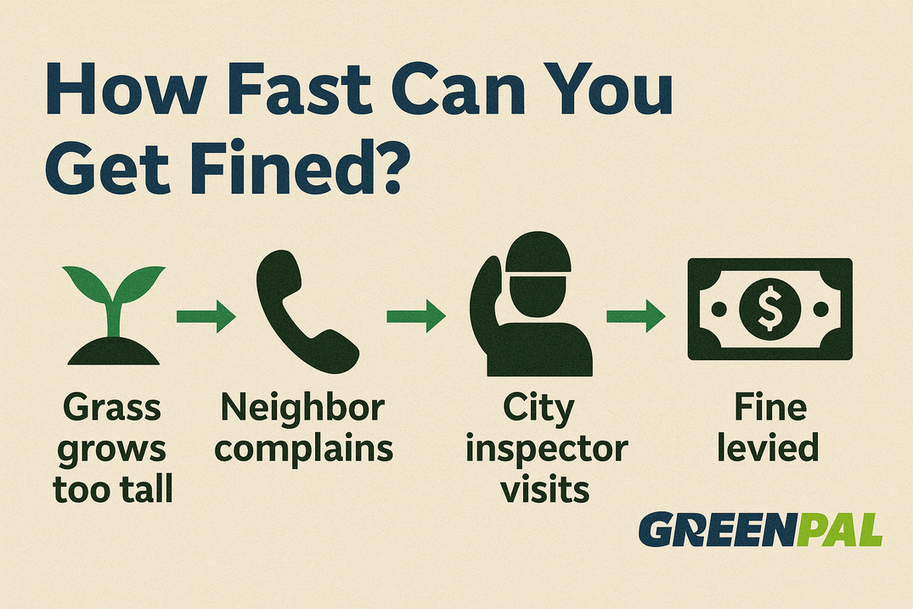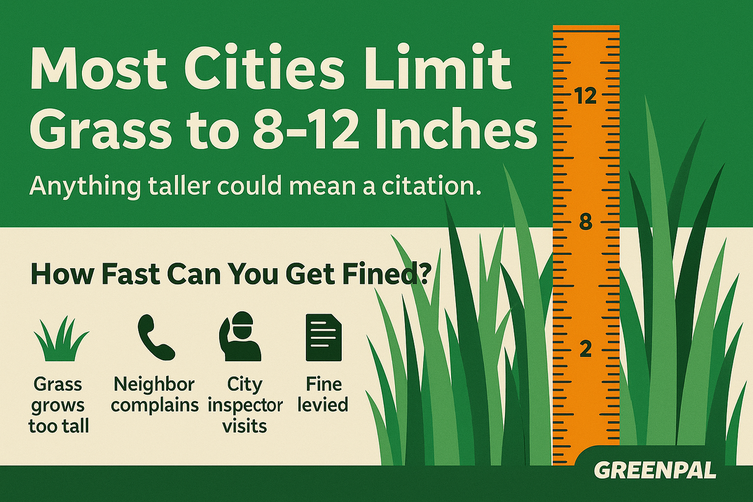The Green Gauntlet: An Exclusive Report Ranking U.S. Cities by Lawn Enforcement Severity
If you’ve ever let your yard get out of hand, you know the worry of a city citation hanging over you. Across the U.S., municipalities issue thousands of tickets and field hundreds of 311 complaints about tall grass and weeds every year. For lawn care providers and homeowners, understanding where the risk is highest can help you stay ahead of fines and keep curb appeal strong.
Using publicly available code enforcement logs, inspector general audits, and 311 service request data, we analyzed which cities are the toughest on overgrown lawns. Then, we adjusted those numbers on a per-capita basis so the rankings reflect how common these actions are for residents.
.png)
Top 10 Strictest Cities in the US For Lawn Enforcement
If you live in any of these areas, you'll want to ensure you have a reliable lawn crew ready to take care of your lawn each week.
| Rank | City | Annual Cases/Complaints | Population (2020) | Per 100k Residents |
|---|---|---|---|---|
| 1 | Corpus Christi, TX | 16,800 | 317,863 | 5,285 |
| 2 | Oklahoma City, OK | 30,000 | 681,054 | 4,405 |
| 3 | Kansas City, MO | 7,000 | 508,090 | 1,378 |
| 4 | San Antonio, TX | 15,000 | 1,434,625 | 1,046 |
| 5 | Detroit, MI | 6,500 | 639,111 | 1,017 |
| 6 | Dallas, TX | 13,000 | 1,304,442 | 997 |
| 7 | Austin, TX | 9,500 | 961,855 | 988 |
| 8 | Houston, TX | 20,241 | 2,304,580 | 878 |
| 9 | Chicago, IL | 22,295 | 2,746,388 | 812 |
| 10 | Philadelphia, PA | 12,000 | 1,603,797 | 749 |
What the Numbers Tell Us
Before diving into the city-by-city results, it’s important to understand what these numbers really represent. Each figure reflects either formal citations, code enforcement cases, or 311 complaints tied to tall grass and weeds. To put this together, we reviewed multiple years of publicly available city audits, municipal reports, and open 311 datasets.
While the method of tracking varies by city, the trend is clear: local governments take lawn maintenance seriously, and they are prepared to respond quickly when properties fall out of compliance. This broader look at the data helps explain why some cities appear higher on the list even if their raw population is smaller.
Corpus Christi leads the pack. With roughly 1,400 tall weed cases per month, homeowners there face the highest per-capita risk of enforcement. City records confirm thousands of weed complaints and actions in just one month, showing this isn’t slowing down.

Oklahoma City follows closely. A reported 30,000 tall grass complaints in a single year highlights how quickly fines can accumulate if lawns are neglected.
Houston shows volume, but context matters. Its 311 category includes weeds, trash, and stagnant water. Still, with more than 20,000 cases annually, it’s a major hotspot.
Chicago focuses on citations. Unlike many cities that track complaints, Chicago issues formal citations for weed cutting. Over 22,000 in one year makes it a true ticket-heavy market.

Other cities are catching up. San Antonio, Dallas, and Austin have robust enforcement systems and consistently appear in top complaint categories. Kansas City, Detroit, and Philadelphia also show strong volumes relative to their population sizes.
Why It Matters for Homeowners
For homeowners, the takeaway is simple: tall grass fines are avoidable. Cities like Corpus Christi and Oklahoma City are examples of municipalities taking aggressive action. Even if you don’t see inspectors daily, once a neighbor logs a complaint, the city has to respond.
Hiring a lawn care service can help you avoid tickets that can cost hundreds of dollars.

Frequently Asked Questions About Tall Grass Citations
How tall can my grass get before I risk a fine?
Most U.S. cities set the maximum height between 8 and 12 inches, but some are stricter. For example, Dearborn, MI, enforces a 6-inch limit, while Milwaukee, WI, caps grass at 7 inches.
How fast can cities take action once my grass is too tall?
It varies. Some places give 10 days to fix the problem (like Madison, WI), while others, especially in Texas, may move forward in as little as 7 days. A few cities even allow immediate enforcement.
What are the fines for tall grass?
Penalties start small in some cities (around $50–$150), but can escalate quickly. In Chicago, each day is a separate offense with fines of $600–$1,200 per day. In Dunedin, FL, a homeowner was charged $500 per day, eventually owing $30,000.

Can the city mow my lawn for me?
Yes. Many cities hire private contractors; if you don’t comply, they will send you the bill. In Fort Worth, TX, this can cost $250 or more. If you don’t pay, the city may also add administrative fees or even place a lien on your property.
Why are cities so strict about lawn care?
Municipalities argue that tall grass attracts pests, creates fire hazards, and lowers neighborhood property values. In short, it’s about public health, safety, and community appearance, not just aesthetics.
What’s the easiest way to avoid fines?
Maintain a consistent mowing schedule, especially after heavy rainfall. If you’re away or too busy, booking a lawn care service ensures you don’t miss compliance windows and risk daily penalties.
Final Thoughts
Cities take tall grass seriously, and the data backs this up. If you’re a homeowner trying to stay fine-free, contact GreenPal today. Many customers receive their first cut in under 24 hours. It could be fast enough to save you hundreds of dollars in fines.
.png)
References: Chicago OIG – Weed-Cutting Program Audit (2019), Oklahoma City FOX25 – Tall Weeds Complaints, KIII-TV Corpus Christi – Tall Grass Violations Report, City of Corpus Christi – March 2025 Code Compliance Report, World Population Review – U.S. Cities Population & Density (2025).





 Share
Share




.png)






